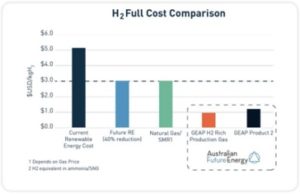Here’s why Australian Future Energy’s hydrogen project is built… different
Energy
Energy
Hydrogen has been the talk of the town but Australian Future Energy’s advanced project has several unique features that separates it from other offerings.
The private company’s Gladstone Energy and Ammonia Project (GEAP) will take coal and put it through a proven gasification process technology to produce hydrogen contained in ammonia and pipeline gas.
Here’s where Australian Future Energy (AFE) differentiates itself from other clean hydrogen projects.
First off the rank is its scale. While most recent projects – particularly those favouring green hydrogen – typically propose to produce about 5,000 tonnes per annum (tpa) to 6,000tpa of the lightest element – GEAP will produce about 230,000tpa of ammonia and 14 PJ of pipeline gas. That’s equal to about 91,000tpa of hydrogen.
Ammonia itself is recognised as the best way to store and transport hydrogen due to its ease of liquification.
Additionally, it has seen increasing use as a transport fuel and for co-firing coal fired power stations. The co-firing is happening now in Japan to reduce emissions.
“We are substantially larger than most, if not all of the green hydrogen producers put together, and many of whom, frankly, are probably going to struggle to sell that offtake because they they’re just don’t have the scale,“ chief executive officer Kerry Parker told Stockhead.
In addition to ammonia, GEAP will also produce about 14 petajoules of gas per annum, allowing the project to generate earnings before interest, taxes, depreciation, and amortisation of about $180m per year.
The second main difference is AFE’s focus on utilising the carbon dioxide rather than proposing just storing carbon dioxide underground, a technology that has been widely criticised.
“That’s the approach that we have taken as a company. Rather than sticking it underground, which is not an absolute solution, finding uses for the CO2 is a much better outcome,” Parker explained.
All this will be achieved at a very affordable initial cost of about US$1.50 per kilogram of hydrogen that Parker notes will ultimately be reduced to all-in-cost of about $US1.25/kg.
“The green hydrogen proponents are currently producing at around US$6 to US$8 a kilogram of hydrogen and there’s an expectation that they’ll be reduced to around US$3 to US$4 a kilogram of hydrogen,” he added.
“So we’re substantially more competitive and it’s because of scale and because of the process.”

GEAP will use an established, commercially proven technology which scales up readily to large scale production that was originally developed in the US by the Gas Technology Institute.
The technology is used in large-scale methanol and pipeline gas plants in five locations across China that were constructed and operated to First World standards.
Adding interest, AFE has the global licence (excluding China) for the technology, which could have interesting benefits for the company.
All the scale and technology would matter little without customers for the project’s products.
Thankfully, AFE has already reached offtake terms with tier one companies for all of its ammonia and natural gas production under long-term agreements.
One of the companies is taking all of the ammonia and about 3.5PJ of gas per annum under a 12-year offtake agreement under a non-binding short-form agreement with all the commercial terms agreed upon. The remaining gas will be taken by a major gas company under a 15-year agreement.
Befitting its belief in using rather than storing the CO2 emissions, which technically turns it into a product, AFE has reached terms with a tier one international group to take 450,000tpa of CO2 for food grade use – typically beverages – and industrial purposes such as refrigeration.
Another 850,000tpa will go to an Australian building materials company that will combine the CO2 with the mineral serpentine to produce building materials such as pavers and tiles.
To top it off, the project has strong support across all levels of government in Australia with Queensland having designated it as a “Project of Significance”. That will speed up approvals as just one state government department will deal with all required approvals.
Parker added that Queensland’s designation of Gladstone as a hydrogen hub will benefit the GEAP, given its location in the port city.
This article was developed in collaboration with Australian Future Energy, a Stockhead advertiser at the time of publishing.
This article does not constitute financial product advice. You should consider obtaining independent advice before making any financial decisions.